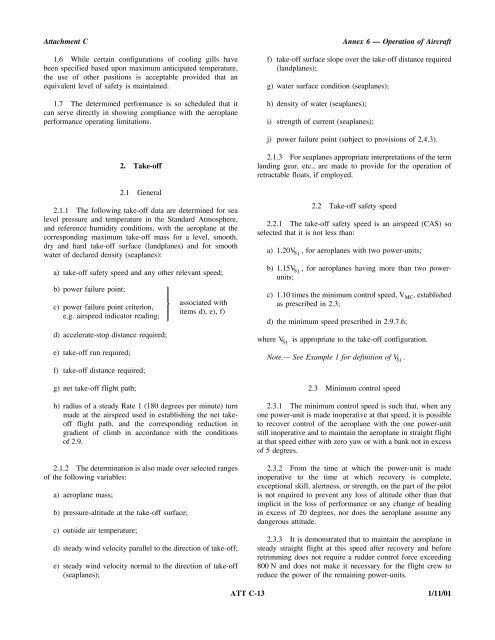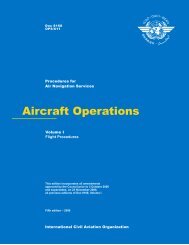Operation of Aircraft
Annex 6, Part I
Annex 6, Part I
- No tags were found...
You also want an ePaper? Increase the reach of your titles
YUMPU automatically turns print PDFs into web optimized ePapers that Google loves.
Attachment C<br />
1.6 While certain configurations <strong>of</strong> cooling gills have<br />
been specified based upon maximum anticipated temperature,<br />
the use <strong>of</strong> other positions is acceptable provided that an<br />
equivalent level <strong>of</strong> safety is maintained.<br />
1.7 The determined performance is so scheduled that it<br />
can serve directly in showing compliance with the aeroplane<br />
performance operating limitations.<br />
Annex 6 — <strong>Operation</strong> <strong>of</strong> <strong>Aircraft</strong><br />
f) take-<strong>of</strong>f surface slope over the take-<strong>of</strong>f distance required<br />
(landplanes);<br />
g) water surface condition (seaplanes);<br />
h) density <strong>of</strong> water (seaplanes);<br />
i) strength <strong>of</strong> current (seaplanes);<br />
j) power failure point (subject to provisions <strong>of</strong> 2.4.3).<br />
2. Take-<strong>of</strong>f<br />
2.1 General<br />
2.1.1 The following take-<strong>of</strong>f data are determined for sea<br />
level pressure and temperature in the Standard Atmosphere,<br />
and reference humidity conditions, with the aeroplane at the<br />
corresponding maximum take-<strong>of</strong>f mass for a level, smooth,<br />
dry and hard take-<strong>of</strong>f surface (landplanes) and for smooth<br />
water <strong>of</strong> declared density (seaplanes):<br />
a) take-<strong>of</strong>f safety speed and any other relevant speed;<br />
b) power failure point;<br />
c) power failure point criterion,<br />
e.g. airspeed indicator reading;<br />
d) accelerate-stop distance required;<br />
e) take-<strong>of</strong>f run required;<br />
f) take-<strong>of</strong>f distance required;<br />
g) net take-<strong>of</strong>f flight path;<br />
h) radius <strong>of</strong> a steady Rate 1 (180 degrees per minute) turn<br />
made at the airspeed used in establishing the net take<strong>of</strong>f<br />
flight path, and the corresponding reduction in<br />
gradient <strong>of</strong> climb in accordance with the conditions<br />
<strong>of</strong> 2.9.<br />
2.1.2 The determination is also made over selected ranges<br />
<strong>of</strong> the following variables:<br />
a) aeroplane mass;<br />
b) pressure-altitude at the take-<strong>of</strong>f surface;<br />
c) outside air temperature;<br />
associated with<br />
items d), e), f)<br />
d) steady wind velocity parallel to the direction <strong>of</strong> take-<strong>of</strong>f;<br />
e) steady wind velocity normal to the direction <strong>of</strong> take-<strong>of</strong>f<br />
(seaplanes);<br />
2.1.3 For seaplanes appropriate interpretations <strong>of</strong> the term<br />
landing gear, etc., are made to provide for the operation <strong>of</strong><br />
retractable floats, if employed.<br />
2.2 Take-<strong>of</strong>f safety speed<br />
2.2.1 The take-<strong>of</strong>f safety speed is an airspeed (CAS) so<br />
selected that it is not less than:<br />
a) 1.20V S 1<br />
, for aeroplanes with two power-units;<br />
b) 1.15V S 1<br />
, for aeroplanes having more than two powerunits;<br />
c) 1.10 times the minimum control speed, V MC , established<br />
as prescribed in 2.3;<br />
d) the minimum speed prescribed in 2.9.7.6;<br />
where V S 1<br />
is appropriate to the take-<strong>of</strong>f configuration.<br />
Note.— See Example 1 for definition <strong>of</strong> V S 1 .<br />
2.3 Minimum control speed<br />
2.3.1 The minimum control speed is such that, when any<br />
one power-unit is made inoperative at that speed, it is possible<br />
to recover control <strong>of</strong> the aeroplane with the one power-unit<br />
still inoperative and to maintain the aeroplane in straight flight<br />
at that speed either with zero yaw or with a bank not in excess<br />
<strong>of</strong> 5 degrees.<br />
2.3.2 From the time at which the power-unit is made<br />
inoperative to the time at which recovery is complete,<br />
exceptional skill, alertness, or strength, on the part <strong>of</strong> the pilot<br />
is not required to prevent any loss <strong>of</strong> altitude other than that<br />
implicit in the loss <strong>of</strong> performance or any change <strong>of</strong> heading<br />
in excess <strong>of</strong> 20 degrees, nor does the aeroplane assume any<br />
dangerous attitude.<br />
2.3.3 It is demonstrated that to maintain the aeroplane in<br />
steady straight flight at this speed after recovery and before<br />
retrimming does not require a rudder control force exceeding<br />
800 N and does not make it necessary for the flight crew to<br />
reduce the power <strong>of</strong> the remaining power-units.<br />
ATT C-13 1/11/01












